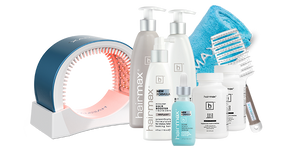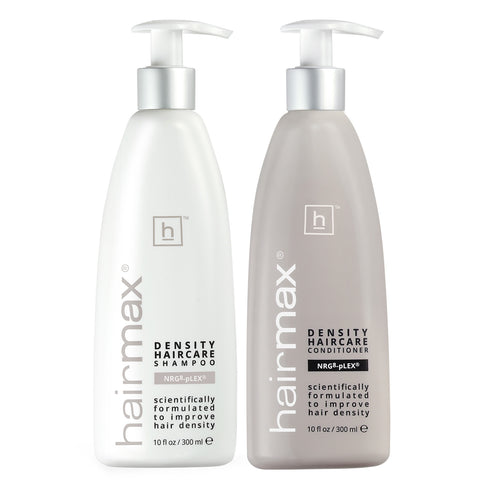The word LASER is an acronym for Light Amplification by the Stimulated Emission of Radiation. When your notice your hair is falling out or you are going bald, you may want to learn about laser therapy for treating this and other cosmetic skin conditions. used by dermatologists for all sorts of aesthetic conditions including hair growth. The wavelength spectrum of visible light shown is shown below which illustrates the many wavelengths and colors emitted by lasers and other sources of energy. The wavelength of the laser light, and the duration of the pulsing or ‘switching’, and the area of the skin being treated determines which laser a dermatologist uses for treating a pattern hair loss.

TYPES OF LASERS USED IN DERMATOLOGY
- LLLT (Low Level Laser Therapy):This type of laser energy gives off no heat and the wavelength of the laser emitted determines the depth of penetration within tissue. For instance wavelength longer than 800 nm will penetrate deeper, so are useful for deeper tissue injuries such as those from sports injuries. For male and female pattern baldness, laser energy does not have to penetrate deep into tissues so laser energy of 660 nm, will only effectively treat male and female pattern baldness, help stop hair falling out. The HairMax LaserComb which is specifically indicated for treating people who are going bald, utilizes this type of laser to effectively and safely treat hair loss, grow hair, and contribute to hair health.
- CO2 lasers: These types of lasers are attracted to water in the skin. They emit a constant beam of light for longer exposure times. They are used in dermatology for skin resurfacing, and for removing superficial skin lesions such as warts, hyperpigmentation, and for superficial removal of benign skin tumors. This type of laser is not useful for treating male and female pattern baldness.
- Nd:YAG lasers: This laser puts out pulsed or interrupted emissions of laser energy. These lasers emit a wavelength of 1064 nm and they use what is called neodymium in yttrium-aluminum-garnet to arrive at this energy level. They are attracted to melanin (pigmentary cells) and hemoglobin in the blood. The application for this type of laser for hair removal, but not for hair falling out. They are also used in laser skin surgeries, to remove spider veins, in rejuvenation of the skin, and for acne treatment. Once again this type of laser is not for hair falling out, but for hair removal.
- QSwitched NdYAG lasers: This laser also pulses and is used mostly to remove tattoos. Here again, this type of laser is not used to treat people who are going bald or who experience hair falling out or have poor hair health.
- ErYAG lasers– These have a wavelength of 2940 nm and they use what is know as Erbium in yttrium-aluminum-garnet. This is also a pulsed laser and it has an affinity for water in the skin. Therefore, it is used for skin resurfacing to rejuvenate skin. Sometimes it is used for removal of skin growth, but it is not used for people with poor hair health or who experience hair falling out.
- Ruby lasers: These lasers emit a wavelength of 694 nm and they contain chromium ions in aluminum oxide as the content. They have a great attraction to melanin in the skin and darker pigments used in tattoos such as black and blue ink so they are very useful in tattoo removal, laser hair removal (for dark hair) and to remove darkly pigmented skin lesions. However, these lasers have not been found useful in treating male and female pattern baldness or for people going bald.
- KTP or Potassium Titanyl Phosphate lasers– These emit 532 nm and are sometimes coupled with NdYAG lasers. They are absorbed by hemoglobin and melanin and are useful for removing superficial pigmented skin lesions. They are not useful for treating hair falling out.
- Alexandrite lasers: With a wavelength of 755 nm this Q Switched laser is good for removing blue, black and green tattoos and superficial skin pigmentary blemishes such as melasma. Not useful for hair health or for hair growth or to prevent hair falling out.
- Diode lasers: These use varying wave length and are absorbed by hemoglobin and melanin in the skin. Used for photo-rejuvenation and superficial vein removal. They are also used for hair removal, but not for treating male and female pattern baldness.
- Dye lasers:They utilize organic compounds in solution such as rhodamine and they have wavelengths of between 400 – 800 nm. They also target hemoglobin and melanin so they are also good for treating superficial spider veins. They are used in photo-rejuvenation, but not to remove surface skin. They are not used to treat male and female pattern hair loss when hair is falling out.
- Excimer lasers: They contain xenon, krypton and argon and they specifically target the proteins and water with wavelength of between 190-350 nm. They are used to treat psoriasis and vitiligo, but are not used to treat people who are going bald.
- Fractional lasers:These lasers in the range of 1550 nm are excellent for finite targeting of treatment zones and can very accurately target skin layers. They are useful for treating acne scars, wrinkles, pigmentary changes, and are now the latest type of laser to use since they only target the lesions and not surrounding tissue. They are targeted beams so they are not useful in treating male and female pattern hair loss nor for improving hair health.
In conclusion, there is a vast and confusing array of lasers in use by dermatologists. Hopefully, this blog post will familiarize you with all of them and give you some idea of the broad uses they have in the treatment of cosmetic conditions.
While it is useful to know of all the lasers used in cosmetic treatment by dermatologists, if you are experiencing hair falling out or you are going bald and have male and female pattern baldness, you only need to know about LLLT . This type of laser energy used by the HairMax LaserComb has treated hundreds of thousands of men and women going bald to effectively and safely treat male and female pattern baldness. It is the only type of laser that can restore hair health, grow hair, and help people who are going bald.










